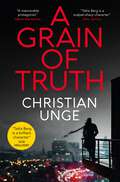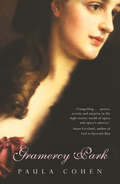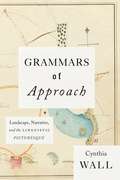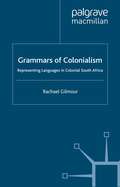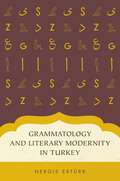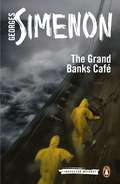- Table View
- List View
A Grain of Faith: Religion in Mid-Century British Literature (Oxford Mid-Century Studies Series)
by Allan HepburnDuring and after the Second World War, there was a concerted thinking about religion in Britain. Not only were leading international thinkers of the day theologians—Ronald Niebuhr, Paul Tillich, Jacques Maritain—but leading writers contributed to discussions about religion. Graham Greene, Muriel Spark, and Barbara Pym incorporated miracles, evil, and church-going into their novels, while Louis MacNeice, T. S. Eliot, and C. S. Lewis gave radio broadcasts about the role of Christianity in contemporary society. Certainly the war revived interest in aspects of Christian life. Salvation and redemption were on many people's minds. The Ministry of Information used images of bombed churches to stoke patriotic fervour, and King George VI led a series of Days of National Prayer that coincided with crucial events in the Allied campaign. After the war and throughout the 1950s, approximately 1.4 million Britons converted to Roman Catholicism as a way of expressing their spiritual ambitions and solidarity with humanity on a world-wide scale. Religion provided one way for writers to answer the question, 'what is man?' It also afforded ways to think about social obligation and ethical engagement. Moreover, the mid-century turn to religion offered ways to articulate statehood, not from the perspective of nationhood and politics, but from the perspective of moral action and social improvement. Instead of being a retreat into seclusion and solitude, the mid-century turn to religion is a call to responsibility.
A Grain of Faith: Religion in Mid-Century British Literature (Oxford Mid-Century Studies Series)
by Allan HepburnDuring and after the Second World War, there was a concerted thinking about religion in Britain. Not only were leading international thinkers of the day theologians—Ronald Niebuhr, Paul Tillich, Jacques Maritain—but leading writers contributed to discussions about religion. Graham Greene, Muriel Spark, and Barbara Pym incorporated miracles, evil, and church-going into their novels, while Louis MacNeice, T. S. Eliot, and C. S. Lewis gave radio broadcasts about the role of Christianity in contemporary society. Certainly the war revived interest in aspects of Christian life. Salvation and redemption were on many people's minds. The Ministry of Information used images of bombed churches to stoke patriotic fervour, and King George VI led a series of Days of National Prayer that coincided with crucial events in the Allied campaign. After the war and throughout the 1950s, approximately 1.4 million Britons converted to Roman Catholicism as a way of expressing their spiritual ambitions and solidarity with humanity on a world-wide scale. Religion provided one way for writers to answer the question, 'what is man?' It also afforded ways to think about social obligation and ethical engagement. Moreover, the mid-century turn to religion offered ways to articulate statehood, not from the perspective of nationhood and politics, but from the perspective of moral action and social improvement. Instead of being a retreat into seclusion and solitude, the mid-century turn to religion is a call to responsibility.
A Grain Of Truth (Virago Modern Classics #92)
by Nina BawdenEmma's anxious and manipulative plea, 'Someone listen to me', opens- and closes- this deliciously uncomfortable novel in which Nina Bawden explores myriad emotional disguises with her characteristic acuity. When Emma's father-in-law falls down the stairs to his death, she is convinced she pushed him in an act of wish-fulfilment. To her husband Henry and her close friend Holly, this is unthinkable. Guilt is simply Emma's obsession in a humdrum domestic existence enlivened by romantic fantasy. For Holly, who successfully fields a string of love affairs, sexual pleasures are more easily attainable, whereas Henry, a Divorce lawyer, prides himself on being a realist. Each tells their story in turn, illuminating and distorting their separate versions of the truth. As they do so, an intricate jigsaw of the private deceits with which they shore up everyday life emerges.
A Grain of Truth
by Christian UngeStressed-out, sleep-deprived and pill-popping Dr Tekla Berg is as unusual a central character as you will find" Irish Independent"Tekla is a terrific character" Literary Review"Tekla Berg is a brilliant character" Susi Holliday"A memorable protagonist" Imran Mahmood"Tekla is a scalpel-sharp character" Jens LapidusA woman is found wandering the corridors of Nobel Hospital in Stockholm, accompanied by a young boy. She appears to be looking for a man who was involved in a car accident earlier that day.Meanwhile, in one of the emergency rooms, Tekla Berg is fighting to save a patient who was seriously injured in the same incident. The resulting chaos goes beyond anything anyone could have predicted, leaving hospital staff, police and everyone else involved equally shocked and perplexed.Hospital Director Monica Carlsson has stepped up her attempts to privatise her fiefdom with the launch of an exclusive patient hotel, a controversial liver transplant unit and the prestigious recruitment of star surgeon Klas Nyström. It soon becomes obvious that Klas has his own agenda and is working to undermine Tekla at every turn.But Tekla is too distracted to meet this challenge head on: she has become obsessed with the mystery surrounding the woman and her young charge - for the boy's identity remains unknown and no trace of his past can be found.Reviews for Hell and High Water"A gripping crime novel . . . fast-moving and packed with convincing detail and memorable characters" Literary Review"As gripping as it could be . . . An authentic and seriously exciting debut" Irish IndependentTranslated from the Swedish by George Goulding and Sarah de Senarclens
Gráinne
by Keith RobertsWinner of the BSFA Award for best novel, 1987Meet Gráinne: blue-stocking seductress, darling of the media, painfully human yet mysterious as her great namesake, the proud girl-goddess who plunged all Ireland into war and shadow...
Gramercy Park: A Novel (Large Print Ser.)
by Paula CohenPaul Cohen’s sumptumous debut novel captures the high drama and low dealings that lie behind the polished facade of fin de siecle New York.
Grammalepsy: Essays on Digital Language Art (Electronic Literature)
by John CayleyCollecting and recontextualizing writings from the last twenty years of John Cayley's research-based practice of electronic literature, Grammalepsy introduces a theory of aesthetic linguistic practice developed specifically for the making and critical appreciation of language art in digital media. As he examines the cultural shift away from traditional print literature and the changes in our culture of reading, Cayley coins the term “grammalepsy” to inform those processes by which we make, understand, and appreciate language.Framing his previous writings within the overall context of this theory, Cayley eschews the tendency of literary critics and writers to reduce aesthetic linguistic making-even when it has multimedia affordances-to “writing.” Instead, Cayley argues that electronic literature and digital language art allow aesthetic language makers to embrace a compositional practice inextricably involved with digital media, which cannot be reduced to print-dependent textuality.
Grammar Matters Too (PDF)
by Michael RossThis book helps you build and improve grammar skills. This new Student Book builds on the success of Grammar Matters, using the same structure but with entirely new content, new features and a new design. It helps all students grasp the fundamental principles of grammar by providing clear and simple explanations of grammatical terms and usage. Readers are engaged in their learning through the use of real world examples, humour, regular peer and self assessment, and full-colour design.
The Grammar of Innovation: A Literary Exploration of Technological and Organizational Change
by Andrea Prencipe Massimo SideriIn Six Memos for the Next Millennium, Italo Calvino elaborated on six concepts or memos to offer insights on the ‘shapes of things to come’, which were lightness, rapidity, exactness, visibility, multiplicity and consistency. To do so, the Italian writer embraced an interdisciplinary approach to describe each concept through juxtaposition of its antonyms, heaviness, slowness, indeterminacy, invisibility, uniqueness, and inconsistency. Inspired by Calvino’s intuition, this book puts forward the notion of the ‘Calvino Method’ to interpret the inner dynamics of innovation processes. Drawing on literature and cases from the fields of innovation, history of technology, organisation theory and corporate strategy, the book elaborates on each of the six concepts to offer a unique angle to understand innovation as technological, organisational and cultural change that generates value across a variety of domains. The linguistic juxtapositions at the root of the CalvinoMethod forms the framework of The Grammar of Innovation and the tension between opposites, which at first seems insoluble, emerges as the catalyst of future thought. This book will be of great interest to scholars of innovation, strategy, organisation studies, philosophy of business, and all those with an interest in the works of Italo Calvino.
Grammars of Approach: Landscape, Narrative, and the Linguistic Picturesque
by Cynthia WallIn Grammars of Approach, Cynthia Wall offers a close look at changes in perspective in spatial design, language, and narrative across the late eighteenth and early nineteenth centuries that involve, literally and psychologically, the concept of “approach.” In architecture, the term “approach” changed in that period from a verb to a noun, coming to denote the drive from the lodge at the entrance of an estate “through the most interesting part of the grounds,” as landscape designer Humphrey Repton put it. The shift from the long straight avenue to the winding approach, Wall shows, swung the perceptual balance away from the great house onto the personal experience of the visitor. At the same time, the grammatical and typographical landscape was shifting in tandem, away from objects and Things (and capitalized common Nouns) to the spaces in between, like punctuation and the “lesser parts of speech”. The implications for narrative included new patterns of syntactical architecture and the phenomenon of free indirect discourse. Wall examines the work of landscape theorists such as Repton, John Claudius Loudon, and Thomas Whately alongside travel narratives, topographical views, printers’ manuals, dictionaries, encyclopedias, grammars, and the novels of Defoe, Richardson, Burney, Radcliffe, and Austen to reveal a new landscaping across disciplines—new grammars of approach in ways of perceiving and representing the world in both word and image.
Grammars of Approach: Landscape, Narrative, and the Linguistic Picturesque
by Cynthia WallIn Grammars of Approach, Cynthia Wall offers a close look at changes in perspective in spatial design, language, and narrative across the late eighteenth and early nineteenth centuries that involve, literally and psychologically, the concept of “approach.” In architecture, the term “approach” changed in that period from a verb to a noun, coming to denote the drive from the lodge at the entrance of an estate “through the most interesting part of the grounds,” as landscape designer Humphrey Repton put it. The shift from the long straight avenue to the winding approach, Wall shows, swung the perceptual balance away from the great house onto the personal experience of the visitor. At the same time, the grammatical and typographical landscape was shifting in tandem, away from objects and Things (and capitalized common Nouns) to the spaces in between, like punctuation and the “lesser parts of speech”. The implications for narrative included new patterns of syntactical architecture and the phenomenon of free indirect discourse. Wall examines the work of landscape theorists such as Repton, John Claudius Loudon, and Thomas Whately alongside travel narratives, topographical views, printers’ manuals, dictionaries, encyclopedias, grammars, and the novels of Defoe, Richardson, Burney, Radcliffe, and Austen to reveal a new landscaping across disciplines—new grammars of approach in ways of perceiving and representing the world in both word and image.
Grammars of Approach: Landscape, Narrative, and the Linguistic Picturesque
by Cynthia WallIn Grammars of Approach, Cynthia Wall offers a close look at changes in perspective in spatial design, language, and narrative across the late eighteenth and early nineteenth centuries that involve, literally and psychologically, the concept of “approach.” In architecture, the term “approach” changed in that period from a verb to a noun, coming to denote the drive from the lodge at the entrance of an estate “through the most interesting part of the grounds,” as landscape designer Humphrey Repton put it. The shift from the long straight avenue to the winding approach, Wall shows, swung the perceptual balance away from the great house onto the personal experience of the visitor. At the same time, the grammatical and typographical landscape was shifting in tandem, away from objects and Things (and capitalized common Nouns) to the spaces in between, like punctuation and the “lesser parts of speech”. The implications for narrative included new patterns of syntactical architecture and the phenomenon of free indirect discourse. Wall examines the work of landscape theorists such as Repton, John Claudius Loudon, and Thomas Whately alongside travel narratives, topographical views, printers’ manuals, dictionaries, encyclopedias, grammars, and the novels of Defoe, Richardson, Burney, Radcliffe, and Austen to reveal a new landscaping across disciplines—new grammars of approach in ways of perceiving and representing the world in both word and image.
Grammars of Approach: Landscape, Narrative, and the Linguistic Picturesque
by Cynthia WallIn Grammars of Approach, Cynthia Wall offers a close look at changes in perspective in spatial design, language, and narrative across the late eighteenth and early nineteenth centuries that involve, literally and psychologically, the concept of “approach.” In architecture, the term “approach” changed in that period from a verb to a noun, coming to denote the drive from the lodge at the entrance of an estate “through the most interesting part of the grounds,” as landscape designer Humphrey Repton put it. The shift from the long straight avenue to the winding approach, Wall shows, swung the perceptual balance away from the great house onto the personal experience of the visitor. At the same time, the grammatical and typographical landscape was shifting in tandem, away from objects and Things (and capitalized common Nouns) to the spaces in between, like punctuation and the “lesser parts of speech”. The implications for narrative included new patterns of syntactical architecture and the phenomenon of free indirect discourse. Wall examines the work of landscape theorists such as Repton, John Claudius Loudon, and Thomas Whately alongside travel narratives, topographical views, printers’ manuals, dictionaries, encyclopedias, grammars, and the novels of Defoe, Richardson, Burney, Radcliffe, and Austen to reveal a new landscaping across disciplines—new grammars of approach in ways of perceiving and representing the world in both word and image.
Grammars of Approach: Landscape, Narrative, and the Linguistic Picturesque
by Cynthia WallIn Grammars of Approach, Cynthia Wall offers a close look at changes in perspective in spatial design, language, and narrative across the late eighteenth and early nineteenth centuries that involve, literally and psychologically, the concept of “approach.” In architecture, the term “approach” changed in that period from a verb to a noun, coming to denote the drive from the lodge at the entrance of an estate “through the most interesting part of the grounds,” as landscape designer Humphrey Repton put it. The shift from the long straight avenue to the winding approach, Wall shows, swung the perceptual balance away from the great house onto the personal experience of the visitor. At the same time, the grammatical and typographical landscape was shifting in tandem, away from objects and Things (and capitalized common Nouns) to the spaces in between, like punctuation and the “lesser parts of speech”. The implications for narrative included new patterns of syntactical architecture and the phenomenon of free indirect discourse. Wall examines the work of landscape theorists such as Repton, John Claudius Loudon, and Thomas Whately alongside travel narratives, topographical views, printers’ manuals, dictionaries, encyclopedias, grammars, and the novels of Defoe, Richardson, Burney, Radcliffe, and Austen to reveal a new landscaping across disciplines—new grammars of approach in ways of perceiving and representing the world in both word and image.
Grammars of Approach: Landscape, Narrative, and the Linguistic Picturesque
by Cynthia WallIn Grammars of Approach, Cynthia Wall offers a close look at changes in perspective in spatial design, language, and narrative across the late eighteenth and early nineteenth centuries that involve, literally and psychologically, the concept of “approach.” In architecture, the term “approach” changed in that period from a verb to a noun, coming to denote the drive from the lodge at the entrance of an estate “through the most interesting part of the grounds,” as landscape designer Humphrey Repton put it. The shift from the long straight avenue to the winding approach, Wall shows, swung the perceptual balance away from the great house onto the personal experience of the visitor. At the same time, the grammatical and typographical landscape was shifting in tandem, away from objects and Things (and capitalized common Nouns) to the spaces in between, like punctuation and the “lesser parts of speech”. The implications for narrative included new patterns of syntactical architecture and the phenomenon of free indirect discourse. Wall examines the work of landscape theorists such as Repton, John Claudius Loudon, and Thomas Whately alongside travel narratives, topographical views, printers’ manuals, dictionaries, encyclopedias, grammars, and the novels of Defoe, Richardson, Burney, Radcliffe, and Austen to reveal a new landscaping across disciplines—new grammars of approach in ways of perceiving and representing the world in both word and image.
Grammars of Colonialism: Representing Languages in Colonial South Africa
by Rachael GilmourThe study of languages was crucial to colonial power in 18th and 19th-century South Africa. This important book examines representations of the South African Bantu languages Xhosa and Zulu, revealing the ways in which colonial linguistics contributed to both the making of the colonial order and to instabilities at the heart of the project.
Grammatology and Literary Modernity in Turkey
by Nergis ErturkThe 1928 Turkish alphabet reform replacing the Perso-Arabic script with the Latin phonetic alphabet is an emblem of Turkish modernization. Grammatology and Literary Modernity in Turkey traces the history of Turkish alphabet and language reform from the mid-nineteenth to the mid-twentieth century, examining its effects on modern Turkish literature. In readings of the novels, essays, and poetry of Ahmed Midhat, Recâizade Mahmud Ekrem, Ömer Seyfeddin, Ahmet Hamdi Tanpinar, Peyami Safa, and Nâzim Hikmet, Nergis Ertürk argues that modern Turkish literature is profoundly self-conscious of dramatic change in its own historical conditions of possibility. Where literary historiography has sometimes idealized the Turkish language reforms as the culmination of a successful project of Westernizing modernization, Ertürk suggests a different critical narrative: one of the consolidation of control over communication, forging a unitary nation and language from a pluralistic and multilingual society.
The Grampian Quartet (Canongate Classics #70)
by Nan ShepherdEdited and introductions by Roderick Watson. The Quarry Wood, although published well before Sunset Song, inhabits a similar world; the progress of its heroine could almost be the alternative story of a Chris Guthrie who did go to university. Compassionate and humorous, the grace and style of Shepherd’s prose is heightened by a superb ear for the vigorous language of the north-east. The Weatherhouse, Shepherd’s masterpiece, is an even more substantial achievement which belongs to the great line of Scottish fiction dealing with the complex interactions of small communities, and especially the community of women – a touching and hilarious network of mothers, daughters, spinsters and widows. It is also a striking meditation on the nature of truth, the power of human longing and the mystery of being. The third and final novel, A Pass in the Grampians, describes Jenny Kilgour’s coming of age as she has to choose between the kindly harshness of her grandfather’s life on a remote hill farm, and the vulgar and glorious energy of Bella Cassie, a local girl who left the community to pursue success as a singer, and has now returned to scandalise them all. The Living Mountain is a lyrical testament in praise of the Cairngorms. It is a work deeply rooted in Shepherd’s knowledge of the natural world, and a poetic and philosophical meditation on our longing for high and holy places. This is the first omnibus edition of Shepherd’s prose works – her sensitivity and powers of observation raise her work far above the status of regional literature and into the front rank of Scottish writing.
The Gramscian Moment: Philosophy, Hegemony And Marxism (Historical Materialism Book Series (PDF))
by P. D. Thomas Peter D. ThomasWinner of the Premio internazionale Giuseppe Sormani 2011, awarded by the Fondazione Istituto Piemontese Antonio Gramsci in Turin for the best book/article on Gramsci in the period between 2007-2011 internationally. Antonio Gramsci's Prison Notebooks are today acknowledged as a classic of the human and social sciences in the twentieth century. The influence of his thought in numerous fields of scholarship is only exceeded by the diverse interpretations and readings to which it has been subjected, resulting in often contradictory 'images of Gramsci'. This book draws on the rich recent season of Gramscian philological studies in order to argue that the true significance of Gramsci's thought consists in its distinctive position in the development of the Marxist tradition. Providing a detailed reconsideration of Gramsci's theory of the state and concept of philosophy, The 'Gramscian moment' argues for the urgent necessity of taking up the challenge of developing a 'philosophy of praxis' as a vital element in the contemporary revitalisation of Marxism.
Gran Meccanismo: Clockpunk Roleplaying in Da Vinci's Florence (Osprey Roleplaying)
by Mark GaleottiIt is the Year of Our Lord 1510, and one has to wonder how differently history could have played out if Niccolò Machiavelli, the military commissioner of the Republic of Florence, had not understood the true scale of Leonardo da Vinci's genius. In such a world, the visionary might simply have wasted his time painting portraits of women and doodling in a sketchbook. Instead, he unleashed a technological revolution where primitive computers, decorated with delicately painted cupids, run on water clocks; spring-powered tanks whir across the battlefield, cannons thundering from their flanks; and gliders flit across perfectly blue Tuscan skies.Gran Meccanismo is a roleplaying game of swashbuckling adventure in a Renaissance Italy where Florence's winding alleys play host to spies, scholars, and sell-swords alike. Players are nobles, mercenaries, inventors, and artisans who may find themselves crossing wits with Machiavelli, avoiding the dangerous charms of Lucretia Borgia, or hearing Christopher Columbus telling tales of the new world he has discovered...
Gran Meccanismo: Clockpunk Roleplaying in Da Vinci's Florence (Osprey Roleplaying)
by Mark GaleottiIt is the Year of Our Lord 1510, and one has to wonder how differently history could have played out if Niccolò Machiavelli, the military commissioner of the Republic of Florence, had not understood the true scale of Leonardo da Vinci's genius. In such a world, the visionary might simply have wasted his time painting portraits of women and doodling in a sketchbook. Instead, he unleashed a technological revolution where primitive computers, decorated with delicately painted cupids, run on water clocks; spring-powered tanks whir across the battlefield, cannons thundering from their flanks; and gliders flit across perfectly blue Tuscan skies.Gran Meccanismo is a roleplaying game of swashbuckling adventure in a Renaissance Italy where Florence's winding alleys play host to spies, scholars, and sell-swords alike. Players are nobles, mercenaries, inventors, and artisans who may find themselves crossing wits with Machiavelli, avoiding the dangerous charms of Lucretia Borgia, or hearing Christopher Columbus telling tales of the new world he has discovered...
Grand Affair: the captivating story of one young woman's struggle to overcome the obstacles of her past, and face the future…
by Charlotte BinghamOttilie Cartaret is born in London into a family of boys dominated by their genial mother, Ma O'Flaherty. For the first four years of her life, all Ottilie knows is love until, that is, the erring father of the boys, the ever absent Mr O'Flaherty, sends enough money from America for the O'Flahertys to move to what Ma imagines will be rural bliss in Cornwall.True, St Elcomb is by the sea and in 1950s Britain is certainly rural but, for the O'Flahertys, it is not bliss. Never mind their poverty or the damp cottage which Ma has bought for them, the enmity of the local people is what proves insuperable.The family unit having been destroyed by Ma's death, Ottilie is adopted by Mr and Mrs Cartaret, a wealthy couple who run the Grand Hotel in St Elcomb. It is to these palatial surroundings that Ottilie is removed, away from her brothers and everything which she loves. Here she becomes pampered and spoilt, not just by her adopted parents but by all the visitors to the hotel, with the exception of their mysterious annual guest whom Ottilie nicknames 'GREY LADY'.Times however are changing and not just for Ottilie but for the hotel too, and as the regulars to the now decaying hotel die off, the Cartarets find they are unable to adapt to modern ways. That Ottilie becomes their greatest asset and they live to rejoice in the day they adopted her is undoubted, but that Ottilie perhaps sacrifices too much herself to save the Grand is something she soon comes to realize...
The Grand Babylon Hotel: A Fantasia On Modern Themes (classic Reprint) (Timeless Classics Ser.)
by Arnold BennettNella, daughter of millionaire Theodore Racksole, orders a dinner of steak and beer at the exclusive Grand Babylon Hotel in London. Her order is refused, so Theodore promptly buys the chef, the kitchen and the whole hotel. But when hotel staff begin to vanish and a German prince goes missing, Nella discovers that murder, blackmail and kidnapping are also on the menu. A rollicking murder mystery from one of the finest writers of the last century.
The Grand Banks Café: Inspector Maigret #8 (Inspector Maigret #8)
by Georges Simenon David CowardA new translation of Georges Simenon's gripping novel set in an insular fishing community, book eight in the new Penguin Maigret series.It was indeed a photograph, a picture of a woman. But the face was completely hidden, scribbled all over in red ink. Someone had tried to obliterate the head, someone very angry. The pen had bitten into the paper. There were so many criss-crossed lines that not a single square millimetre had been left visible.On the other hand, below the head, the torso had not been touched. A pair of large breasts. A light-coloured silk dress, very tight and very low cut.Sailors don't talk much to other men, especially not to policemen. But after Captain Fallut's body is found floating near his trawler, they all mention the Evil Eye when they speak of the Ocean's voyage.Penguin is publishing the entire series of Maigret novels in new translations. This novel has been published in a previous translation as The Sailors' Rendezvous.'Compelling, remorseless, brilliant' John Gray'One of the greatest writers of the twentieth century . . . Simenon was unequalled at making us look inside, though the ability was masked by his brilliance at absorbing us obsessively in his stories' Guardian 'A supreme writer . . . unforgettable vividness' Independent


